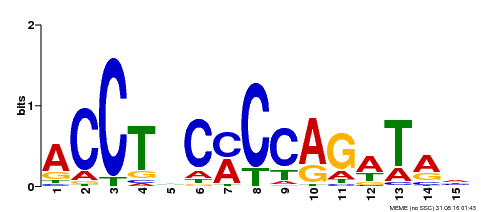 |
PlantRegMap/PlantTFDB v5.0
Plant Transcription
Factor Database
|
| Home TFext BLAST Prediction Download Help About Links PlantRegMap |
Transcription Factor Information
| Basic Information? help Back to Top | |||||||||
|---|---|---|---|---|---|---|---|---|---|
| TF ID | CCG026547.1 | ||||||||
| Organism | |||||||||
| Taxonomic ID | |||||||||
| Taxonomic Lineage |
cellular organisms; Eukaryota; Viridiplantae; Streptophyta; Streptophytina; Embryophyta; Tracheophyta; Euphyllophyta; Spermatophyta; Magnoliophyta; Mesangiospermae; eudicotyledons; Gunneridae; Pentapetalae; rosids; fabids; Malpighiales; Salicaceae; Saliceae; Populus
|
||||||||
| Family | C2H2 | ||||||||
| Protein Properties | Length: 509aa MW: 56520.3 Da PI: 6.1071 | ||||||||
| Description | C2H2 family protein | ||||||||
| Gene Model |
|
||||||||
| Signature Domain? help Back to Top | |||||||
|---|---|---|---|---|---|---|---|
| No. | Domain | Score | E-value | Start | End | HMM Start | HMM End |
| 1 | zf-C2H2 | 21.1 | 8.5e-07 | 275 | 296 | 2 | 23 |
EETTTTEEESSHHHHHHHHHHT CS
zf-C2H2 2 kCpdCgksFsrksnLkrHirtH 23
C++Cgk F+r nL+ H+r H
CCG026547.1 275 FCTICGKGFKRDANLRMHMRGH 296
6*******************98 PP
| |||||||
| Protein Features ? help Back to Top | ||||||
|---|---|---|---|---|---|---|
| Database | Entry ID | E-value | Start | End | InterPro ID | Description |
| SuperFamily | SSF57667 | 2.25E-5 | 272 | 299 | No hit | No description |
| PROSITE profile | PS50157 | 12.03 | 274 | 301 | IPR007087 | Zinc finger, C2H2 |
| SMART | SM00355 | 0.0026 | 274 | 296 | IPR015880 | Zinc finger, C2H2-like |
| Gene3D | G3DSA:3.30.160.60 | 7.2E-6 | 275 | 325 | IPR013087 | Zinc finger C2H2-type/integrase DNA-binding domain |
| PROSITE pattern | PS00028 | 0 | 276 | 296 | IPR007087 | Zinc finger, C2H2 |
| SMART | SM00355 | 56 | 323 | 356 | IPR015880 | Zinc finger, C2H2-like |
| SMART | SM00355 | 24 | 361 | 383 | IPR015880 | Zinc finger, C2H2-like |
| Gene Ontology ? help Back to Top | ||||||
|---|---|---|---|---|---|---|
| GO Term | GO Category | GO Description | ||||
| GO:0006355 | Biological Process | regulation of transcription, DNA-templated | ||||
| GO:0010044 | Biological Process | response to aluminum ion | ||||
| GO:0010447 | Biological Process | response to acidic pH | ||||
| GO:0005634 | Cellular Component | nucleus | ||||
| GO:0003676 | Molecular Function | nucleic acid binding | ||||
| GO:0003700 | Molecular Function | transcription factor activity, sequence-specific DNA binding | ||||
| GO:0046872 | Molecular Function | metal ion binding | ||||
| Sequence ? help Back to Top |
|---|
| Protein Sequence Length: 509 aa Download sequence Send to blast |
MEPKDRLSLD AWANPSSSSN GLPRKMALEN PSFTNFNLRQ QEQKWDDTSI LDYGIRIEPP 60 FQEFNQASES EYLLSSNCNK QPKVLDQEDG QDNEALQTSK LQDWDPRSML NNLSFLEEKI 120 HHLRDLVHLI VGRKGQALGG QDQLVTQQQQ LITADLTSII VQLISTAGSL LPSVKHTLST 180 GTPNGQFGQL GGLLFPPLAG MNCVPQPQHG SGSKVSDQCN QMDVTGNCGT EQNHSTEELE 240 MKEEEDADEG ENLPPGSYDI LQLEKEEILA PHTHFCTICG KGFKRDANLR MHMRGHGDEY 300 KTPAALAKPN KEPSSEPVII KRYSCPFAGC KRNKDHKKFQ PLKTILCVKN HYKRTHCDKS 360 YICSRCNTKK FSVMADLKTH EKHCGKDKWL CSCGTTFSRK DKLFGHIALF QGHTPAIPLE 420 ETKGPHASCD KVDGNEASNK GGNTNFSLGF NAGSGSGVQN VIEVKEDADD PASYFSPLSF 480 DTCNFGGFHE FPRPPFDDSE SPFSFLEAP |
| Functional Description ? help Back to Top | ||||||
|---|---|---|---|---|---|---|
| Source | Description | |||||
| UniProt | Probable transcription factor. Together with STOP2, plays a critical role in tolerance to major stress factors in acid soils such as proton H(+) and aluminum ion Al(3+). Required for the expression of genes in response to acidic stress (e.g. ALMT1 and MATE), and Al-activated citrate exudation. {ECO:0000269|PubMed:17535918, ECO:0000269|PubMed:18826429, ECO:0000269|PubMed:19321711, ECO:0000269|PubMed:23935008}. | |||||
| Binding Motif ? help Back to Top | |||
|---|---|---|---|
| Motif ID | Method | Source | Motif file |
| MP00196 | ampDAP | Transfer from AT1G34370 | Download |

| |||
| Regulation -- Description ? help Back to Top | ||||||
|---|---|---|---|---|---|---|
| Source | Description | |||||
| UniProt | INDUCTION: By shock H(+) and Al(3+) treatments. {ECO:0000269|PubMed:17535918}. | |||||
| Annotation -- Nucleotide ? help Back to Top | ||||||
|---|---|---|---|---|---|---|
| Source | Hit ID | E-value | Description | |||
| GenBank | AB811778 | 0.0 | AB811778.1 Populus nigra PnSTOP1 mRNA for STOP1-like protein, complete cds. | |||
| Annotation -- Protein ? help Back to Top | |||||||
|---|---|---|---|---|---|---|---|
| Source | Hit ID | E-value | Description | ||||
| Refseq | XP_011038155.1 | 0.0 | PREDICTED: protein SENSITIVE TO PROTON RHIZOTOXICITY 1 | ||||
| Swissprot | Q9C8N5 | 0.0 | STOP1_ARATH; Protein SENSITIVE TO PROTON RHIZOTOXICITY 1 | ||||
| TrEMBL | B9MW64 | 0.0 | B9MW64_POPTR; Uncharacterized protein | ||||
| STRING | POPTR_0013s11900.1 | 0.0 | (Populus trichocarpa) | ||||
| Orthologous Group ? help Back to Top | |||
|---|---|---|---|
| Lineage | Orthologous Group ID | Taxa Number | Gene Number |
| Fabids | OGEF5340 | 32 | 54 |
| Best hit in Arabidopsis thaliana ? help Back to Top | ||||||
|---|---|---|---|---|---|---|
| Hit ID | E-value | Description | ||||
| AT1G34370.2 | 0.0 | C2H2 family protein | ||||



